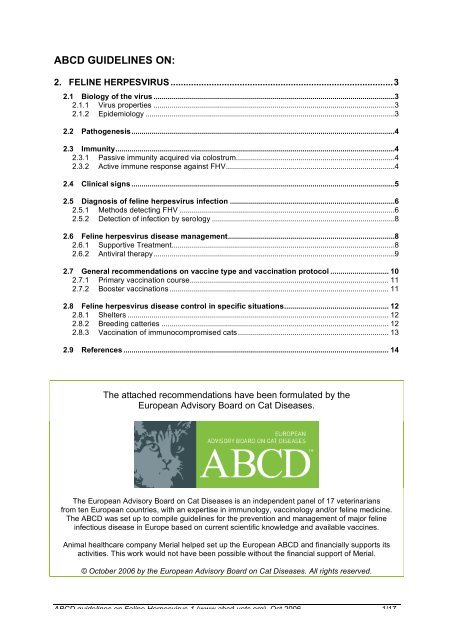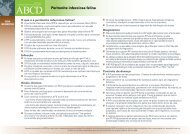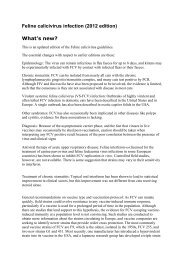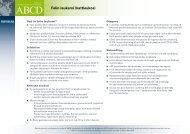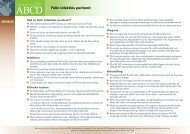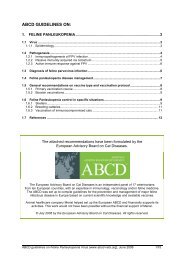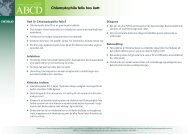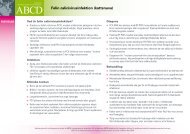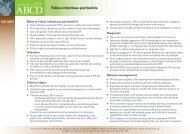abcd guidelines on - The European Advisory Board on Cat Diseases
abcd guidelines on - The European Advisory Board on Cat Diseases
abcd guidelines on - The European Advisory Board on Cat Diseases
Create successful ePaper yourself
Turn your PDF publications into a flip-book with our unique Google optimized e-Paper software.
ABCD GUIDELINES ON:2. FELINE HERPESVIRUS .......................................................................................32.1 Biology of the virus ........................................................................................................................32.1.1 Virus properties ........................................................................................................................32.1.2 Epidemiology ............................................................................................................................32.2 Pathogenesis...................................................................................................................................42.3 Immunity...........................................................................................................................................42.3.1 Passive immunity acquired via colostrum...............................................................................42.3.2 Active immune resp<strong>on</strong>se against FHV....................................................................................42.4 Clinical signs ...................................................................................................................................52.5 Diagnosis of feline herpesvirus infecti<strong>on</strong> ..................................................................................62.5.1 Methods detecting FHV ...........................................................................................................62.5.2 Detecti<strong>on</strong> of infecti<strong>on</strong> by serology ...........................................................................................82.6 Feline herpesvirus disease management...................................................................................82.6.1 Supportive Treatment...............................................................................................................82.6.2 Antiviral therapy........................................................................................................................92.7 General recommendati<strong>on</strong>s <strong>on</strong> vaccine type and vaccinati<strong>on</strong> protocol ............................. 102.7.1 Primary vaccinati<strong>on</strong> course................................................................................................... 112.7.2 Booster vaccinati<strong>on</strong>s ............................................................................................................. 112.8 Feline herpesvirus disease c<strong>on</strong>trol in specific situati<strong>on</strong>s.................................................... 122.8.1 Shelters .................................................................................................................................. 122.8.2 Breeding catteries ................................................................................................................. 122.8.3 Vaccinati<strong>on</strong> of immunocompromised cats........................................................................... 132.9 References .................................................................................................................................... 14<strong>The</strong> attached recommendati<strong>on</strong>s have been formulated by the<strong>European</strong> <strong>Advisory</strong> <strong>Board</strong> <strong>on</strong> <strong>Cat</strong> <strong>Diseases</strong>.<strong>The</strong> <strong>European</strong> <strong>Advisory</strong> <strong>Board</strong> <strong>on</strong> <strong>Cat</strong> <strong>Diseases</strong> is an independent panel of 17 veterinariansfrom ten <strong>European</strong> countries, with an expertise in immunology, vaccinology and/or feline medicine.<strong>The</strong> ABCD was set up to compile <str<strong>on</strong>g>guidelines</str<strong>on</strong>g> for the preventi<strong>on</strong> and management of major felineinfectious disease in Europe based <strong>on</strong> current scientific knowledge and available vaccines.Animal healthcare company Merial helped set up the <strong>European</strong> ABCD and financially supports itsactivities. This work would not have been possible without the financial support of Merial.© October 2006 by the <strong>European</strong> <strong>Advisory</strong> <strong>Board</strong> <strong>on</strong> <strong>Cat</strong> <strong>Diseases</strong>. All rights reserved.ABCD <str<strong>on</strong>g>guidelines</str<strong>on</strong>g> <strong>on</strong> Feline Herpesvirus-1 (www.<str<strong>on</strong>g>abcd</str<strong>on</strong>g>-vets.org), Oct 2006 1/17
2. Feline herpesvirus2.1 Biology of the virus2.1.1 Virus propertiesFeline herpesvirus (FHV) is the agent of feline viral rhinotracheitis and is distributedworldwide. <strong>The</strong> virus bel<strong>on</strong>gs to the family Herpesviridae, subfamily Alphaherpesvirinae,genus Varicellovirus. Although <strong>on</strong>ly <strong>on</strong>e serotype is described, the virulence can differbetween viral strains (Gaskell et al. 2007). Some differences can also be observed byrestricti<strong>on</strong> end<strong>on</strong>uclease analysis of viral DNA (Hamano et al. 2005; Thiry 2006).FHV is a typical herpesvirus: the genomic double-stranded DNA is packaged into anicosahedral capsid surrounded by a proteinaceous tegument and a phospholipid envelope. Atleast ten different glycoproteins are present <strong>on</strong> the envelope. FHV grows in both epithelialcells of the c<strong>on</strong>junctiva and the upper respiratory tract, and in neur<strong>on</strong>es. <strong>The</strong> neur<strong>on</strong>alinfecti<strong>on</strong> enables the virus to establish lifel<strong>on</strong>g latency after primary infecti<strong>on</strong>. FHV is relatedantigenically to canine herpesvirus and phocid herpesviruses 1 and 2, although there is noknown cross species transfer (Gaskell et al., 2006).<strong>The</strong> virus is inactivated within 3 hours at 37°C and is susceptible to most commerciallyavailable disinfectants, antiseptics and detergents. At low temperatures, the virus has shownto remain infective for five m<strong>on</strong>ths (154 days at 4°C), although its survival is shorter at highertemperatures (33 days at 25°C, 4-5 minutes at 56°C) (Pedersen, 1987).2.1.2 Epidemiology<strong>The</strong> domestic cat is the main host of FHV but the virus has been isolated also from otherfelids, including cheetahs and li<strong>on</strong>s, and antibodies have been detected in pumas. <strong>The</strong>re is noevidence of human infecti<strong>on</strong>.Latent chr<strong>on</strong>ic infecti<strong>on</strong> is the typical outcome for FHV acute infecti<strong>on</strong> and intermittentreactivati<strong>on</strong> gives rise to viral shedding in or<strong>on</strong>asal and c<strong>on</strong>junctival secreti<strong>on</strong>s. Apart from incatteries, c<strong>on</strong>taminati<strong>on</strong> of the envir<strong>on</strong>ment is not a primary source for transmissi<strong>on</strong>. Virusshedding from acutely infected cats and from latently infected cats experiencing reactivati<strong>on</strong>are the two main sources of infecti<strong>on</strong> (Gaskell and Povey, 1982).Transplacental infecti<strong>on</strong> has not been dem<strong>on</strong>strated in the field. Latently infected queens maytransmit FHV to their offspring because parturiti<strong>on</strong> and lactati<strong>on</strong> are typical stress-inducingfactors leading to viral reactivati<strong>on</strong> and shedding. Kittens may therefore acquire FHVinfecti<strong>on</strong> at a very early age before vaccinati<strong>on</strong>. <strong>The</strong> outcome depends <strong>on</strong> the level ofmaternally derived antibodies (MDA). When high levels are present, kittens are protectedagainst disease and develop subclinical infecti<strong>on</strong> leading to latency whereas in the absence ofsufficient MDA, clinical disease may follow (Gaskell and Povey, 1992).In healthy small populati<strong>on</strong>s, the prevalence of viral shedding may be less than 1% whereas inlarge populati<strong>on</strong>s, especially with clinical disease present, prevalence may be up to 10 20%(Coutts et al., 1994; Binns et al., 2000; Helps et al., 2005). In shelters, risk of c<strong>on</strong>tagi<strong>on</strong> ishigher: with <strong>on</strong>ly 4% of shedding cats entering the shelter, 50% of cats present may excretethe virus <strong>on</strong>e week later (Pedersen et al., 2004). This low prevalence is likely to reflect theintermittent nature of viral shedding during latency.ABCD <str<strong>on</strong>g>guidelines</str<strong>on</strong>g> <strong>on</strong> Feline Herpes Virus 3/17
2.2 Pathogenesis<strong>The</strong> virus enters via the nasal, oral or c<strong>on</strong>junctival routes. It causes a lytic infecti<strong>on</strong> of thenasal epithelium with spread to the c<strong>on</strong>junctival sac, pharynx, trachea, br<strong>on</strong>chi andbr<strong>on</strong>chioles. Lesi<strong>on</strong>s are characterised by multifocal necrosis of epithelium, with neutrophilicinfiltrati<strong>on</strong> and inflammati<strong>on</strong>. A transient viraemia associated with blood m<strong>on</strong><strong>on</strong>uclear cellscan be observed rarely after natural infecti<strong>on</strong>. This may be observed excepti<strong>on</strong>ally in ne<strong>on</strong>atesor hypothermic individuals as viral replicati<strong>on</strong> is usually restricted to lower temperaturetissues (Gaskell et al., 2007).Viral excreti<strong>on</strong> starts as so<strong>on</strong> as 24 hours after infecti<strong>on</strong> and lasts for 1 to 3 weeks. Acutedisease resolves within 10 to 14 days. Some animals may develop chr<strong>on</strong>ic lesi<strong>on</strong>s in the upperrespiratory tract and ocular tissues.During infecti<strong>on</strong>, the virus spreads al<strong>on</strong>g the sensory nerves and reaches neur<strong>on</strong>s, particularlyin the trigeminal ganglia, which are the main sites of latency. Almost all cats experiencingprimary infecti<strong>on</strong> become lifel<strong>on</strong>g latent carriers. <strong>The</strong>re are no direct diagnostic methods toidentify latency, because the virus persists as genomic DNA in the nucleus of the latentlyinfected neur<strong>on</strong>s without virus replicati<strong>on</strong>. Reactivati<strong>on</strong> of virus shedding can be inducedexperimentally by glucocorticoid treatment in approximately 70% of cats. Other stressors thatmay cause reactivati<strong>on</strong> include lactati<strong>on</strong> (40 %), and the cat moving into a new envir<strong>on</strong>ment(18%) (Gaskell and Povey, 1977; Ellis, 1981; Gaskell and Povey, 1982; Pedersen et al., 2004).Some adult cats may show acute lesi<strong>on</strong>s at the time of viral reactivati<strong>on</strong>. Disease atreactivati<strong>on</strong> is referred to as recrudescence.C<strong>on</strong>junctivitis may be associated with corneal ulcers, which may develop into chr<strong>on</strong>icsequestra. Stromal keratitis is a sec<strong>on</strong>dary immune-mediated reacti<strong>on</strong> due to the presence ofvirus in the epithelium or the stroma. In some cases damage to the nasal turbinates in acutedisease is thought to predispose some cats to developing chr<strong>on</strong>ic rhinitis (Gaskell et al., 2007)2.3 Immunity2.3.1 Passive immunity acquired via colostrumKittens are protected against disease by maternally derived antibodies (MDA) during the firstweeks of their lives but in general levels of MDA for FHV infecti<strong>on</strong> are low. It has beendem<strong>on</strong>strated that MDA may persist for 2-10 weeks (Johns<strong>on</strong> & Povey, 1985) although in amore recent study levels of MDA were shown to be low, with approximately 25% of kittensappearing negative for MDA as early as 6 weeks of age (Daws<strong>on</strong> et al., 2001).2.3.2 Active immune resp<strong>on</strong>se against FHVGlycoproteins embedded in the membrane of the herpesviruses are important in the inducti<strong>on</strong>of immunity; following infecti<strong>on</strong> the detecti<strong>on</strong> of virus neutralizing antibodies (VNA)correlates with the recogniti<strong>on</strong> of FHV glycoproteins (Burgener and Maes, 1988).Furthermore, immunisati<strong>on</strong> of rabbits with FHV-gD led to the producti<strong>on</strong> of high titres ofVNAs, indicating a role of these proteins in the inducti<strong>on</strong> of VNA (Spatz et al., 1994).Solid immunity is not induced after natural infecti<strong>on</strong>; in general the immune resp<strong>on</strong>se protectsagainst disease but not against infecti<strong>on</strong> and mild clinical signs have been observed followingreinfecti<strong>on</strong>, <strong>on</strong>ly 150 days after primary infecti<strong>on</strong> (Gaskell and Povey, 1979). <strong>The</strong> titres ofVNA induced by natural infecti<strong>on</strong> are often low and rise slowly. Indeed, VNA may still beabsent 40 days post infecti<strong>on</strong> (Gaskell and Povey, 1979). VNA most likely c<strong>on</strong>tribute to theABCD <str<strong>on</strong>g>guidelines</str<strong>on</strong>g> <strong>on</strong> Feline Herpes Virus 4/17
protecti<strong>on</strong> against acute infecti<strong>on</strong>. Other antibody-mediated mechanisms e.g. antibodymediated cellular cytotoxicity (ADCC) and antibody-induced complement lysis have beendem<strong>on</strong>strated (Wardley, 1976). However, (as with other alpha-herpesviruses) cell-mediatedcellular immunity plays an important role in protecti<strong>on</strong>, since the absence of detectable serumantibody levels in vaccinated cats does not necessarily indicate that cats are susceptible todisease (Lappin et al., 2002). On the other hand, seroc<strong>on</strong>versi<strong>on</strong> did correlate with protecti<strong>on</strong>against virulent FHV challenge (Lappin et al., 2002). It is important to take into c<strong>on</strong>siderati<strong>on</strong>that presence of antibodies against any infectious agent may provide an indirect indicati<strong>on</strong> ofcellular immune resp<strong>on</strong>ses, since T-lymphocytes are required for maintenance of B-lymphocyte functi<strong>on</strong>.Although a general correlati<strong>on</strong> between presence of antibodies to FHV and protecti<strong>on</strong> againstclinical signs has been dem<strong>on</strong>strated for FHV infecti<strong>on</strong>, there is currently no reliable testavailable that predicts the degree of protecti<strong>on</strong> in individual cats.Since FHV is a pathogen of the respiratory tract, mucosal cellular and humoral resp<strong>on</strong>ses areimportant. Several studies with intranasal vaccines have shown clinical benefits as early as 2-6 days after vaccinati<strong>on</strong> (Lappin et al., 2006; Weigler et al., 1997, Slater & York, 1976).2.4 Clinical signsTable 2.1. FHV Disease forms, lesi<strong>on</strong>s and clinical signs [Note: c<strong>on</strong>current infecti<strong>on</strong> withother agents is required to determine the aetiology of chr<strong>on</strong>ic rhinitis]Disease type C<strong>on</strong>sequences Main clinical manifestati<strong>on</strong>sClassical acute disease(cytolytic disease)Atypical acute diseaseChr<strong>on</strong>ic disease(immune-mediated disease)FHV related diseaseswith no definitive causalassociati<strong>on</strong>Source: ABCDRhinitis, c<strong>on</strong>junctivitis,superficial and deep cornealulcers, in particular dendriticulcersSkin diseaseViraemia, pneum<strong>on</strong>iaStromal keratitisChr<strong>on</strong>ic rhinosinusitisCorneal sequestraEosinophilic keratitisNeurological disease?UveitisSneezing, nasal discharge,c<strong>on</strong>junctival hyperaemia andserous dischargeNasal and facial ulcerated andcrusting lesi<strong>on</strong>sSevere systemic signs,coughing, death (acute deathin kittens, “fading kittens”)Corneal oedema,vascularisati<strong>on</strong>, blindnessChr<strong>on</strong>ic sneezing and nasaldischargeFHV infecti<strong>on</strong> typically causes acute upper respiratory and ocular disease, which can beparticularly severe in young kittens. Viral replicati<strong>on</strong> causes the erosi<strong>on</strong> and ulcerati<strong>on</strong> ofmucosal surfaces, producing rhinitis, c<strong>on</strong>junctivitis and, occasi<strong>on</strong>ally, corneal ulcerativedisease, mainly dendritic ulcers which are c<strong>on</strong>sidered a pathognom<strong>on</strong>ic clinical manifestati<strong>on</strong>(Maggs, 2005).ABCD <str<strong>on</strong>g>guidelines</str<strong>on</strong>g> <strong>on</strong> Feline Herpes Virus 5/17
Typical clinical signs are pyrexia, depressi<strong>on</strong> and anorexia, serous or serosanguineous ocularand/or nasal discharge, c<strong>on</strong>junctival hyperaemia, sneezing and, less frequently, salivati<strong>on</strong> andcoughing (Gaskell et al., 2006). Sec<strong>on</strong>dary bacterial infecti<strong>on</strong> is comm<strong>on</strong> in which casesecreti<strong>on</strong>s tend to become purulent. In certain susceptible kittens, the disease may be moresevere and FHV infecti<strong>on</strong> has been associated with primary pneum<strong>on</strong>ia and a viraemic statethat can produce severe generalized signs and eventually death (Gaskell et al., 2006).Less frequent clinical signs associated with FHV are oral ulcerati<strong>on</strong> or dermatitis and skinulcers (Hargis et al, 1999) and neurological signs (Gaskell et al., 2006). Aborti<strong>on</strong> may occuras a rare sec<strong>on</strong>dary clinical sign, although, in c<strong>on</strong>trast to other herpesviruses, it is not a directc<strong>on</strong>sequence of viral replicati<strong>on</strong>.After reactivati<strong>on</strong> and recrudescent disease, some cats may show acute cytolytic disease asdescribed above. Others may show chr<strong>on</strong>ic ocular immune-mediated disease in resp<strong>on</strong>se tothe presence of FHV virus. Str<strong>on</strong>g experimental evidence suggests that stromal keratitis,associated with corneal oedema, inflammatory cell infiltrates and vascularisati<strong>on</strong> andeventually blindness, is an example of this disease mechanism (Nasisse et al., 1989; Maggs,2005).Corneal sequestra and eosinophilic keratitis in cats have been linked to the presence of FHVin the cornea and/or blood in some of the affected cats. However, a definite causal associati<strong>on</strong>cannot be made since some affected cats are negative to FHV (Cullen et al., 2005, Nasisse etal., 1998). FHV DNA has been also detected in aqueous humor of a larger proporti<strong>on</strong> of catssuffering from uveitis compared to healthy cats, suggesting that FHV may cause uvealinflammati<strong>on</strong> (Maggs et al., 1999).Chr<strong>on</strong>ic rhinosinusitis, a frequent cause of chr<strong>on</strong>ic sneezing and nasal discharge in cats, hasbeen associated with FHV infecti<strong>on</strong>. Viral DNA can be detected in some affected cats, but isalso found in c<strong>on</strong>trols without clinical signs (Henders<strong>on</strong> et al., 2004). Recent investigati<strong>on</strong>sshow that the virus is not actively replicating in such cats, suggesting that chr<strong>on</strong>icrhinosinusitis might be initiated by FHV infecti<strong>on</strong>, but perpetuated by immune-mediatedmechanisms producing inflammatory and remodelling phenomena, leading to permanentdestructi<strong>on</strong> of nasal turbinates and b<strong>on</strong>e complicated by sec<strong>on</strong>dary bacterial infecti<strong>on</strong>(Johns<strong>on</strong> et al., 2005).Very often, FHV infecti<strong>on</strong> occurs combined with feline calicivirus and/or Chlamydophilafelis, Bordetella br<strong>on</strong>chiseptica, Mycoplasma spp. and other micro-organisms, includingStaphylococcus spp., Escherichia coli, may lead to sec<strong>on</strong>dary infecti<strong>on</strong> of the respiratorytract, causing a multi-agent respiratory syndrome (Gaskell et al., 2006).2.5 Diagnosis of feline herpesvirus infecti<strong>on</strong>2.5.1 Methods detecting FHVPCR is now the preferred method to detect FHV in biological samples. Viral isolati<strong>on</strong> lostinterest but is a valid method still used in several laboratories. <strong>The</strong> sensitivity and thespecificity of the tests, and especially PCR, are good but may differ depending <strong>on</strong> thelaboratory because there is no harm<strong>on</strong>isati<strong>on</strong>. <strong>The</strong>se tests, and immunofluorescence aredescribed in this chapter.2.5.1.1 Detecti<strong>on</strong> of nucleic acidPCR is currently used to detect FHV DNA in c<strong>on</strong>junctival, corneal or oropharyngeal swabs,corneal scrapings, aqueous humor, corneal sequestra, blood or biopsies. C<strong>on</strong>venti<strong>on</strong>al PCR,ABCD <str<strong>on</strong>g>guidelines</str<strong>on</strong>g> <strong>on</strong> Feline Herpes Virus 6/17
nested-PCR and real-time PCR are used routinely to detect FHV DNA in diagnosticlaboratories (Hara et al., 1996; Helps et al., 2003; Marsilio et al, 2004; Maggs et al., 1999a;Nasisse et al., 1997; Stiles et al., 1997a, 1997b; Sykes et al 2001, Vögtlin et al., 2002; Weigleret al., 1997). Most PCR primers are based <strong>on</strong> the highly c<strong>on</strong>served thymidine kinase gene.Molecular diagnostic methods appear to be more sensitive than virus isolati<strong>on</strong> or indirectimmunofluorescence (Burgesser et al., 1999; Reubel et al., 1993; Stiles et al., 1997; Weigleret al., 1997).Because the very low amounts of viral nucleic acids detectable by PCR may not be associatedwith disease, PCR positive results should be interpreted with cauti<strong>on</strong>. <strong>The</strong> sensitivity of PCRdepends <strong>on</strong> the test (Maggs and Clarke, 2005) and it is advisable to use a system that includesa c<strong>on</strong>trol that detects feline DNA to give an indicati<strong>on</strong> of how much material was <strong>on</strong> theswab, and to check for substances that might inhibit PCR. Due to its high sensitivity, PCRmay also detect viral DNA in scrapings of the cornea and/or t<strong>on</strong>sils suggesting n<strong>on</strong>productiveinfecti<strong>on</strong> (Maggs et al., 1999b; Reubel et al., 1993; Stiles et al., 1997a).C<strong>on</strong>sequently its predictive value for clinical infecti<strong>on</strong> may be poor, depending <strong>on</strong> the testsensitivity, the samples analysed (corneal scrapings and biopsies more frequently yieldpositive results than c<strong>on</strong>junctival <strong>on</strong>es) and the populati<strong>on</strong> tested (e.g. shelter cats are morelikely to test positive than owned pet cats).Additi<strong>on</strong>ally, many if not all PCR tests are able to detect FHV DNA in modified-live vaccines(Maggs and Clarke, 2005) and it is not presently known if vaccinal strains may be detected inrecently vaccinated animals and if so, for how l<strong>on</strong>g after vaccinati<strong>on</strong>.A positive PCR result may represent low level shedding or viral latency and does not meanthat the virus is resp<strong>on</strong>sible for clinical signs, although it indicates the possibility of recurringsigns in the future. However, when quantitative real-time PCR is used (Vögtlin et al., 2002),the viral load present in the material tested may provide additi<strong>on</strong>al informati<strong>on</strong> <strong>on</strong> theetiological importance of the agent. When high loads are present in the nasal secreti<strong>on</strong> ortears, this suggests active replicati<strong>on</strong> and therefore involvement of the virus in the clinicalsigns. If low copy numbers are detected in corneal scrapings, this would indicate a latentinfecti<strong>on</strong>.Molecular diagnosis may be more c<strong>on</strong>venient for clinicians, because the use of fluoresceindoes not interfere with specificity of the test and samples can be mailed over several days atambient temperature (Maggs 2005). It also allows the simultaneous detecti<strong>on</strong> in the samesamples of other feline pathogens frequently implicated in respiratory and ocular diseases,especially Chlamydophila felis and, less reliably, feline calicivirus (Helps et al., 2003;Marsilio et al., 2004).2.5.1.2 Virus isolati<strong>on</strong>If PCR is not available, virus isolati<strong>on</strong> (VI) is an alternative method of diagnosing FHVinfecti<strong>on</strong>. Virus isolati<strong>on</strong> is less sensitive than PCR but does indicate that replicati<strong>on</strong>competentvirus, not just DNA is present. VI also allows the simultaneous detecti<strong>on</strong> of felinecalicivirus.In cats undergoing primary FHV infecti<strong>on</strong>, the virus can be easily detected by isolati<strong>on</strong> fromc<strong>on</strong>junctival, nasal or pharyngeal swabs or scrapings, or from post-mortem lung samples Butduring chr<strong>on</strong>ic infecti<strong>on</strong>s when the aetiological origin of disease has to be c<strong>on</strong>firmed, VI maybe more difficult.Asymptomatic carriers may also be detected by VI and both positive and negative predictivevalues of VI appear to be low in some studies (Gaskell and Povey, 1977; Maggs et al.,1999b). Samples must be collected before applicati<strong>on</strong> of fluorescein or Rose Bengal stainABCD <str<strong>on</strong>g>guidelines</str<strong>on</strong>g> <strong>on</strong> Feline Herpes Virus 7/17
which can inhibit viral replicati<strong>on</strong> in cell culture (Brooks et al., 1994; Storey et al., 2002) andclinical specimens should be sent quickly to the laboratory and is ideally refrigerated duringshipping. For logistic reas<strong>on</strong>s and despite its good sensitivity in acute disease, VI is notroutinely used for FHV infecti<strong>on</strong> diagnosis.2.5.1.3 Immunofluorescent assay (IFA)FHV-specific proteins can be detected by immunofluorescent assay (IFA) <strong>on</strong> c<strong>on</strong>junctival orcorneal smears or biopsy. As for VI, fluorescein instillati<strong>on</strong> should be avoided beforesampling. For IFA, this may give false positive results and interfere with the interpretati<strong>on</strong> ofthe test. IFA has been reported to be less sensitive than VI or PCR, especially in chr<strong>on</strong>icinfecti<strong>on</strong>s (Nasisse et al., 1993; Burgesser et al., 1999). Although no correlati<strong>on</strong> between VIand IFA testing has been observed, combinati<strong>on</strong> of VI and IFA may predict the presence ofvirus better than either test al<strong>on</strong>e (Nasisse et al., 1993; Maggs et al., 1999b). Because of lackof sensitivity and the interference with fluorescein, often used in ophthalmology practice, IFAis not the most suitable diagnostic test in chr<strong>on</strong>ic ocular diseases (Nasisse et al., 1993).2.5.2 Detecti<strong>on</strong> of infecti<strong>on</strong> by serologyFHV antibodies can be detected by serum neutralizati<strong>on</strong> or ELISA in serum, aqueous humourand cerebrospinal fluid (Daws<strong>on</strong> et al., 1998; Maggs et al., 1999b). <strong>The</strong> seroprevalence isvery high in cats due to natural infecti<strong>on</strong> and vaccinati<strong>on</strong>. C<strong>on</strong>sequently, the presence ofspecific antibodies does not correlate with disease and active infecti<strong>on</strong> (Maggs et al., 1999b).Moreover, antibody detecti<strong>on</strong> does not allow differentiati<strong>on</strong> between infected and vaccinatedanimals, neutralizing antibodies are undetectable until 20 to 30 days after a primary infecti<strong>on</strong>and antibody titres may be low in animals with either acute or chr<strong>on</strong>ic disease. C<strong>on</strong>sequentlyserology has a very limited value in the diagnosis of feline herpesvirus infecti<strong>on</strong> (Nasisse andWeigler, 1997; Maggs et al., 1999b; Maggs, 2005).2.6 Feline herpesvirus disease management2.6.1 Supportive Treatment<strong>The</strong> restorati<strong>on</strong> of fluids, electrolytes and the acid-base balance (e.g. replacement of losses ofpotassium and bicarb<strong>on</strong>ate due to salivati<strong>on</strong> and reduced food intake), preferably byintravenous administrati<strong>on</strong>, is required in cats with severe clinical signs. Food intake isextremely important. Many cats with FHV infecti<strong>on</strong> do not eat because of their loss of smelldue to nasal c<strong>on</strong>gesti<strong>on</strong> or because of ulcers in the oral cavity. Food may be blended to causeless pain when eating, should be highly palatable, and may be warmed up to increase thesmell. Appetite stimulants (e.g. cyproheptadine) may be used. If the cat is not eating for morethan three days, placement of a nasal or an oesophageal feeding tube is indicated.Antibiotics should be given to treat all acute cases of feline upper respiratory tract disease toprevent sec<strong>on</strong>dary bacterial infecti<strong>on</strong>s. Broad-spectrum antibiotics with good penetrati<strong>on</strong> inthe respiratory tract should be given.<strong>Cat</strong>s severely affected by FHV need intensive nursing care and appropriate supportive therapyis very important. If there is nasal discharge, this should be cleaned away several times a daywith physiologic saline soluti<strong>on</strong>, and be treated afterwards with local ointment. Drugs withmucolytic effects (e.g. bromhexine) may be helpful. Eye drops or ointment can beABCD <str<strong>on</strong>g>guidelines</str<strong>on</strong>g> <strong>on</strong> Feline Herpes Virus 8/17
administered several times a day. Nebulisati<strong>on</strong> with saline can be used to combat dehydrati<strong>on</strong>of the airways.Vitamins are sometimes used although their value is unclear.2.6.2 Antiviral therapyTable 2.2. Antiviral drugs recommended for the treatment of acute FHV ocular disease. <strong>The</strong>drugs are listed in decreasing order of preference.DrugTrifluridineFeline IFNωType ofdrugNucleosideanalogueInterfer<strong>on</strong>Route ofadministrati<strong>on</strong>TopicalUse every hour for 1stday and every 4 hoursthereafter (Maggs, 2001)Systemic1 MU/kg SC sid or eodEfficacyin vitroEfficacy invivoC<strong>on</strong>trolledstudy invivo?CommentsExcellent n.d. no Topical treatment of choicein ocular FHVmanifestati<strong>on</strong>s. Some catsaverse to applicati<strong>on</strong>topically. Toxic if givensystemically. (Maggs, 2001)yes n.d. no Safe and licensed for use incats.HumanIFN-αInterfer<strong>on</strong>Oral50,000 – 100,000 UnitsdailyTopicaldilute 10MU vial in19ml 0.9% NaCl and useas eye drops: 2 drops ineach eye 5 times a dayfor 10 days (J<strong>on</strong>gh,2004).SC high dosePO low dose5-35 Units dailyyesyesyesyesyesyesNo published c<strong>on</strong>trolled invivo studies for use of thisproduct in FHV infecti<strong>on</strong> attime of writing.Used al<strong>on</strong>g with l-lysine inchr<strong>on</strong>ic infecti<strong>on</strong>s.Less bioactive than felineinterfer<strong>on</strong>.5-35 Units daily reducesclinical disease but not FHVshedding. Used al<strong>on</strong>g with l-lysine in chr<strong>on</strong>ic infecti<strong>on</strong>s.L-lysine Amino-acid Oral250 mg bid or 400 mgsidIdoxuridineGanciclovirAcyclovirNucleosideanalogueNucleosideanalogueNucleosideanalogueTopicaluse initially ever 2-4hours (Maggs, 2001)yes yes yes Safe, reduces sp<strong>on</strong>taneousocular viral shedding rate inlatently infected cats (Maggs,et al, 2000; Maggs, et al,2001; Stiles et al. 2002;Maggs et al, 2003)excellent n.d. no Topical treatment for ocularFHV. Difficult to source,pharmacists can formulate a0.1% ophthalmic soluti<strong>on</strong>.Toxic if given systemically.Topical excellent n.d. n.d. Topical treatment for ocularFHV. Good in vitro activityagainst FHV (van derMeulen et al, 2006; Maggs etal, 2004)Topical and oralPoor(high dosesmay beneeded toovercomesome yes Minimal in vitro effect of allthe anti-herpesvirals (van derMeulen et al, 2006, Williamset al., 2004), moderate inABCD <str<strong>on</strong>g>guidelines</str<strong>on</strong>g> <strong>on</strong> Feline Herpes Virus 9/17
viralresistance)vivo effect (Williams et al.,2005). Marked synergy incombinati<strong>on</strong> with humanIFN−α (Weiss, 1989). Toxicsystematically. (Maggs,2001)n.d. = not determined; eod = every other day; sid = <strong>on</strong>ce daily; bid = twice daily; tid = threetimes daily.It should be noted that the above drugs may not be readily available or licensed for cats.Other drugs have been proposed for the treatment of FHV ocular infecti<strong>on</strong>s, includingbromovinyldeoyuridine, cidofovir, HPMA, pencyclovir, ribavirin, valacyclovir, vidarabine,foscarnet and lactoferrin. However, the efficacy of these drugs is not supported by appropriatedata.2.7 General recommendati<strong>on</strong>s <strong>on</strong> vaccine type andvaccinati<strong>on</strong> protocolFHV infecti<strong>on</strong> is comm<strong>on</strong> and may induce severe disease. ABCD therefore recommends thatall cats should be vaccinated against FHV. FHV-vaccines provide protecti<strong>on</strong> by inducing bothhumoral immunity, associated with a serological resp<strong>on</strong>se, and cellular immunity.Vaccinati<strong>on</strong> provides good protecti<strong>on</strong> against clinical disease, but in comm<strong>on</strong> with manylocalised respiratory tract infecti<strong>on</strong>s, it does not provide 100% protecti<strong>on</strong> (approx. 90+%reducti<strong>on</strong> in clinical scores has been achieved following experimental challenge so<strong>on</strong> aftervaccinati<strong>on</strong>)(Gaskell et al., 2007). Less effective protecti<strong>on</strong> can be expected in somevaccinated individuals in particular circumstances following exposure to virus, e.g. extremechallenge, immunosuppressi<strong>on</strong>. <strong>The</strong>re is no evidence that any variati<strong>on</strong> in isolates of FHVcreates problems in protecti<strong>on</strong> provided by vaccinati<strong>on</strong>.Vaccinati<strong>on</strong> protects from the development of clinical signs, but not necessarily frominfecti<strong>on</strong>. However, there is some evidence that it can reduce subsequent excreti<strong>on</strong> of virus.(Gaskell et al., 2007).Currently, FHV vaccines are usually combined with FCV, either in divalent vaccines (<strong>on</strong>ly insome countries) or, more comm<strong>on</strong>ly with other antigens. Both modified live and inactivatedparenteral vaccines are available. Subunit FHV-vaccines and modified intranasal vaccineshave been available previously or are available outside Europe, however they are notcurrently available in Europe.Both inactivated and modified live FHV vaccines have relative advantages and disadvantages.<strong>The</strong>re is generally little reas<strong>on</strong> to prefer any specific FHV vaccine for routine vaccinati<strong>on</strong>,particularly since these are all based <strong>on</strong> a single serotype. Modified live vaccines retain somepathogenic potential and may rarely induce disease if administered incorrectly, i.e.accidentally aerosolised or intake of vaccine virus spilt <strong>on</strong> the skin.<strong>The</strong> value of serological tests in predicting protecti<strong>on</strong> is c<strong>on</strong>troversial. Methodological issuescan complicate comparis<strong>on</strong> of titres and some suggest that titres are not good predictors ofprotecti<strong>on</strong>. In other studies, cats without any evidence of seroc<strong>on</strong>versi<strong>on</strong> appear to showprotecti<strong>on</strong> (Lappin et al., 2002; Mouzin 2004). <strong>Cat</strong>s that have been vaccinated usually developan anamnaestic resp<strong>on</strong>se following exposure.ABCD <str<strong>on</strong>g>guidelines</str<strong>on</strong>g> <strong>on</strong> Feline Herpes Virus 10/17
2.7.1 Primary vaccinati<strong>on</strong> courseABCD recommends that all kittens should be vaccinated against FHV. Maternally derivedimmunity can interfere with the resp<strong>on</strong>se to vaccinati<strong>on</strong> and the primary course of vaccinati<strong>on</strong>is usually started at around nine weeks of age, although some vaccines are licensed for use atan earlier age. Kittens should receive a sec<strong>on</strong>d vaccinati<strong>on</strong> two to four weeks later, with thesec<strong>on</strong>d given around twelve weeks of age. This protocol has been developed to ensureoptimal protecti<strong>on</strong>. For l<strong>on</strong>ger intervals, no informati<strong>on</strong> is available and a new primaryvaccinati<strong>on</strong> course should be c<strong>on</strong>sidered.In c<strong>on</strong>trast to vaccines against certain other infectious agents, where single vaccinati<strong>on</strong> isacceptable for cats of unknown or uncertain vaccinati<strong>on</strong> status, in the case of FHV, theyshould also receive two vaccinati<strong>on</strong>s at an interval of two to four weeks, irrespective of thevaccinati<strong>on</strong> type.2.7.2 Booster vaccinati<strong>on</strong>sVaccinati<strong>on</strong> against FHV prevents disease, reduces virus shedding and recrudescence.Although the issue of recommended intervals between boosters is c<strong>on</strong>troversial, in view ofcurrently available scientific evidence, ABCD recommends that boosters should be given atannual intervals to protect individual cats against FHV field infecti<strong>on</strong>s, with the excepti<strong>on</strong> ofcats in low-risk situati<strong>on</strong>s (e.g. indoor-<strong>on</strong>ly cats without c<strong>on</strong>tact to other cats). In these cases,three-yearly intervals would be recommended. An informed decisi<strong>on</strong> should be made <strong>on</strong> thebasis of a risk-benefit analysis, but annual boosters are particularly important to cats that maybe exposed to high risk situati<strong>on</strong>s e.g. entry to boarding catteries, breeding cats.Experimental studies and serological studies in field situati<strong>on</strong>s clearly indicate that immunityagainst FHV lasts l<strong>on</strong>ger than <strong>on</strong>e year in most vaccinated cats (Lappin et al., 2002, Mouzinet al., 2004). However, there is a significant proporti<strong>on</strong> of cats for which this is not true. Fieldstudies have shown that almost 100% of cats either have serological titres against FCV andFPV, or show an anamnestic resp<strong>on</strong>se following administrati<strong>on</strong> of a booster vaccine, butaround 30% of the cat populati<strong>on</strong> appear to have no detectable titres against FHV and around20% fail to show an anamnestic resp<strong>on</strong>se following booster vaccinati<strong>on</strong>s (Lappin et al., 2002,Mouzin et al., 2004). Assessment of the durati<strong>on</strong> of protecti<strong>on</strong> is complicated by failure ofvaccinati<strong>on</strong> to provide 100% clinical protecti<strong>on</strong> shortly after vaccinati<strong>on</strong> has beenadministered, but in experimental vaccine efficacy studies, the efficacy of protecti<strong>on</strong> affordedby vaccinati<strong>on</strong> clearly decreases with time.If booster vaccinati<strong>on</strong>s have lapsed, a single injecti<strong>on</strong> is c<strong>on</strong>sidered adequate if the intervalsince the last vaccinati<strong>on</strong> is less than three years, but if it is more than three years, twovaccinati<strong>on</strong>s should be c<strong>on</strong>sidered to ensure that optimal protecti<strong>on</strong> is provided.Boosters using FHV vaccines produced by another manufacturer are acceptable.<strong>Cat</strong>s that have recovered from disease associated with FHV may not have lifel<strong>on</strong>g protecti<strong>on</strong>against further episodes of disease. Furthermore, in most cases, definitive identificati<strong>on</strong> of theinfectious agent involved in diagnostic testing will not usually have been undertaken and thecat may be susceptible to infecti<strong>on</strong> with other respiratory tract pathogens. <strong>The</strong>refore,vaccinati<strong>on</strong> of recovered cats is generally recommended.ABCD <str<strong>on</strong>g>guidelines</str<strong>on</strong>g> <strong>on</strong> Feline Herpes Virus 11/17
2.8 Feline herpesvirus disease c<strong>on</strong>trol in specific situati<strong>on</strong>s2.8.1 SheltersFHV can represent a particular problem in cat shelters. Management to prevent and limit thepotential for transfer of infecti<strong>on</strong> is as important as vaccinati<strong>on</strong> in c<strong>on</strong>trol. In shelters wherethe incoming cats are mixed, very high infecti<strong>on</strong> rates for FHV are frequently encountered.New cats should be quarantined for the first two weeks and cats should be kept individually –unless known to originate from the same household. <strong>The</strong> design of the shelter andmanagement used should be aimed at avoiding cross infecti<strong>on</strong> of cats. New cats should bevaccinated as so<strong>on</strong> as possible <strong>on</strong>ce they have been assessed as healthy and noc<strong>on</strong>traindicati<strong>on</strong>s to vaccinati<strong>on</strong> have been identified. If there is a particular high risk, i.e. pastor recent infecti<strong>on</strong> with FHV in the shelter, a modified live vaccine may be preferable as itmay provide earlier protecti<strong>on</strong>. If acute respiratory infecti<strong>on</strong> occurs in a shelter, definitivediagnosis of the agent involved with differentiati<strong>on</strong> of FHV and FCV can be useful indeciding <strong>on</strong> the appropriate preventative measures that should be adopted.2.8.2 Breeding catteriesFHV can be a major problem in breeding catteries. Infecti<strong>on</strong> most often appears as aninfecti<strong>on</strong> in young kittens prior to weaning. It typically occurs at around 4-8 weeks asmaternally derived immunity (MDI) wanes. <strong>The</strong> source of infecti<strong>on</strong> is frequently the motherwho is a carrier and has shown reactivati<strong>on</strong> of latent infecti<strong>on</strong> following the stress of kitteningand lactati<strong>on</strong>.Infecti<strong>on</strong> in such young kittens can be severe and frequently involves all the kittens in thelitter. Mortality can be a c<strong>on</strong>sequence and some kittens that recover from acute disease are leftwith chr<strong>on</strong>ic complicati<strong>on</strong>s, most notably chr<strong>on</strong>ic rhinitis. Vaccinati<strong>on</strong> of the queen will notprevent this problem since it will not prevent the queen from becoming a carrier. However, ifthe queen has a good antibody titre, this should ensure that the kittens benefit from goodlevels of MDI through the colostrum, providing protecti<strong>on</strong> for the first m<strong>on</strong>th or so of life.Booster vaccinati<strong>on</strong>s of the queen may therefore be indicated to ensure transfer of str<strong>on</strong>glevels of MDI; this should ideally take place prior to mating. Vaccinati<strong>on</strong> during pregnancymay be c<strong>on</strong>sidered if this has been overlooked previously. However, vaccines are not licensedfor use in pregnant cats and in this situati<strong>on</strong>, an inactivated vaccine may be preferable.Breeding management plays a crucial role in c<strong>on</strong>trol of FHV in breeding catteries.Queens should kitten in isolati<strong>on</strong> and the litter should not mix with other cats until they havebeen fully vaccinated to avoid the risk of exposure to potential carrier cats. Early vaccinati<strong>on</strong>should be c<strong>on</strong>sidered for litters from queens that have had infected litters previously or forwhich there is c<strong>on</strong>cern of infecti<strong>on</strong>. <strong>The</strong> earliest age for which FHV vaccines are licensed foruse is 6 weeks but kittens may become susceptible to infecti<strong>on</strong> earlier than this as MDI wanesand vaccinati<strong>on</strong> from around 4 weeks of age may be c<strong>on</strong>sidered. This is usually repeatedevery 2 weeks until the primary vaccinati<strong>on</strong> course is given in the normal way.Early weaning into isolati<strong>on</strong> from around 4 weeks of age is an alternative approach toprotecting kittens from potential exposure of infecti<strong>on</strong> from their mother. <strong>The</strong>re are noreliable tests that will identify which queens are carriers and predict which may potentiallyinfect their own kittens.ABCD <str<strong>on</strong>g>guidelines</str<strong>on</strong>g> <strong>on</strong> Feline Herpes Virus 12/17
2.8.3 Vaccinati<strong>on</strong> of immunocompromised catsVaccines may not efficiently stimulate immunity in animals with a substantially compromisedimmune functi<strong>on</strong>. Such situati<strong>on</strong>s include the presence of systemic diseases, viral-inducedimmunodeficiency, nutriti<strong>on</strong>al deficiencies, genetic immunodeficiencies, c<strong>on</strong>currentadministrati<strong>on</strong> of immunosuppressive drugs and severe, prol<strong>on</strong>ged stress. Such patientsshould be protected from potential exposure to infectious agents where possible but it may benecessary to c<strong>on</strong>sider vaccinati<strong>on</strong> to ensure protecti<strong>on</strong>. It is generally suggested that aninactivated vaccine is preferable in this situati<strong>on</strong>, based <strong>on</strong> safety c<strong>on</strong>siderati<strong>on</strong>s, althoughthere is no evidence to support this recommendati<strong>on</strong>.2.8.3.1 FIV positive catsIt is important that FIV-positive cats that are clinically healthy are protected against FHV.An effective approach is to c<strong>on</strong>fine cats indoors and limit potential for exposure. If this is notpossible, vaccinati<strong>on</strong> should be c<strong>on</strong>sidered. C<strong>on</strong>cerns have been raised that vaccinati<strong>on</strong> mayc<strong>on</strong>tribute to progressi<strong>on</strong> of disease, but this may be outweighed by the benefit of protecti<strong>on</strong>in a potentially immunocompromised cat. It is possible that other infecti<strong>on</strong>s may c<strong>on</strong>tribute toFIV progressi<strong>on</strong>.In FIV-positive cats with a history of clinical problems that are well c<strong>on</strong>trolled and in astable medical c<strong>on</strong>diti<strong>on</strong>, vaccinati<strong>on</strong> should be c<strong>on</strong>sidered to ensure protecti<strong>on</strong> is maintained.In cats that are sick with FIV-related problems, vaccinati<strong>on</strong> is generally c<strong>on</strong>tra-indicated as inany systemically ill cat.2.8.3.2 FeLV-positive cats<strong>The</strong> same c<strong>on</strong>siderati<strong>on</strong>s apply to FeLV-positive cats as to FIV-positive cats. Vaccinati<strong>on</strong> isc<strong>on</strong>tra-indicated if there are clinical signs related to the FeLV infecti<strong>on</strong> but, if the cat appearsto be clinically healthy, vaccinati<strong>on</strong> should be c<strong>on</strong>sidered to maintain protecti<strong>on</strong> if preventi<strong>on</strong>of potential exposure to FHV cannot be ensured.2.8.3.3 Chr<strong>on</strong>ic diseaseBooster vaccinati<strong>on</strong> should be c<strong>on</strong>tinued in cats with stable chr<strong>on</strong>ic medical c<strong>on</strong>diti<strong>on</strong>s, suchas hyperthyroidism and renal disease. Such cats are often elderly and the c<strong>on</strong>sequences ofinfecti<strong>on</strong> can be particularly severe.2.8.3.4 <strong>Cat</strong>s receiving corticosteroids or other immunosuppressive drugsIn cats receiving corticosteroids, vaccinati<strong>on</strong> should be c<strong>on</strong>sidered carefully. Depending <strong>on</strong>dosage and durati<strong>on</strong> of treatment, corticosteroids may cause suppressi<strong>on</strong> of immuneresp<strong>on</strong>ses. <strong>The</strong> effect of corticosteroids <strong>on</strong> vaccine efficacy in cats is not known. However,c<strong>on</strong>current use of corticosteroids at the time of vaccinati<strong>on</strong> should be avoided if possible.ABCD <str<strong>on</strong>g>guidelines</str<strong>on</strong>g> <strong>on</strong> Feline Herpes Virus 13/17
2.9 ReferencesBinns SH, Daws<strong>on</strong> S, Speakman AJ, Cuevas LE, Hart CA, Gaskell CJ, Morgan KL, GaskellRM (2000). A study of feline upper respiratory tract disease with reference to prevalence andrisk factors for infecti<strong>on</strong> with feline calicivirus and feline herpesvirus. J Feline Med Surg,2:123-133Brooks SE, Kaza V, Nakamura T, Trousdale MD (1994). Photoinactivati<strong>on</strong> of herpes simplexvirus by rose bengal and fluorescein In vitro and in vivo studies. Cornea, 13:43-50Burgener DC, Maes RK (1988). Glycoprotein-specific immune resp<strong>on</strong>ses in cats afterexposure to feline herpesvirus-1. Am J Vet Res 49: 1673-1676Burgesser KM, Hotaling S, Schiebel A, Ashbaugh SE, Roberts SM, Collins JK (1999).Comparis<strong>on</strong> of PCR, virus isolati<strong>on</strong>, and indirect fluorescent antibody, staining in thedetecti<strong>on</strong> of naturally occurring feline herpesvirus infecti<strong>on</strong>s. J Vet Diag Invest 11:122-126Cave TA, Thomps<strong>on</strong> H, Reid SWJ, Hodgs<strong>on</strong> DR, Addie DD (2002). Kitten mortality in theUnited Kingdom, a retrospective analysis of 274 histopathological examinati<strong>on</strong>s (1986-2000).Vet Rec 151(17).:497-501Coutts AJ, Daws<strong>on</strong> S, Willoughby K, Gaskell RM (1994). Isolati<strong>on</strong> of feline respiratoryviruses from clinically healthy cats at UK cat shows. Vet Rec 135(23).:555-6Cullen CL, Wadowska DW, Singh A, Melekhovets Y (2005). Ultrastructural findings infeline corneal sequestra. Vet Ophthalmol 8(5).:295-303Daws<strong>on</strong>, DA, Carman J Collins, J, Hill S, Lappin MR (1998). Enzyme-linked immunosorbentassay for detecti<strong>on</strong> of feline herpesvirus 1 IgG in serum, aqueous humour, and cerebrospinalfluid. J Vet Diag Invest 10: 315-319Daws<strong>on</strong> S, Willoughby K, Gaskell RM, Woog G, WCK Chalmers (2001). A field trial toassess the effect of vaccinati<strong>on</strong> against feline herpesvirus, feline calicivirus and felinepanleukopenia virus in 6-week-old kittens J Feline Med Surg 3:17-22Ellis TM (1981). Feline respiratory virus carriers in clinically healthy cats Aust Vet J57(3).:115-8Gaskell R, Daws<strong>on</strong> S, Radford A (2006). Feline respiratory disease In Infectious disease ofthe dog and cat, Greene C E (Ed), WB Saunders, Missouri, pp 145-154Gaskell R, Daws<strong>on</strong> S, Radford A, Thiry E (2007). Feline herpesvirus. Vet Res (in press).Gaskell RM, Povey RC (1977). Experimental inducti<strong>on</strong> of feline viral rhinotracheitis (FVR).virus re-excreti<strong>on</strong> in FVR-recovered cats. Veterinary Record 100:128-133Gaskell RM, Povey RC (1982). Transmissi<strong>on</strong> of feline viral rhinotracheitis. Vet Rec, 111:359-62Hara M, Fukuyama M, Suzuki Y, Kisikawa S, Ikeda T, Kiuchi A, Tabuchi K (1996).Detecti<strong>on</strong> of feline herpes virus 1 DNA by the nested polymerase chain reacti<strong>on</strong>. VetMicrobiol 48:345-352Hargis AM, Ginn PE (1999). Ulcerative facial and nasal dermatitis and stomatitis in catsassociated with Feline herpesvirus-1. Vet Dermatol 10:267-274Helps C, Reeves N, Egan K, Howard P, Harbour D (2003). Detecti<strong>on</strong> of Chlamydophila felisand Feline herpes virus by multiplex real-time PCR analysis. J Clin Microbiol, 41:2734-2736ABCD <str<strong>on</strong>g>guidelines</str<strong>on</strong>g> <strong>on</strong> Feline Herpes Virus 14/17
Helps CR, Lait P, Damhuis A, Bjornhammar U, Bolta D, Brovida C, Chabanne L, EgberinkH, F<strong>on</strong>tb<strong>on</strong>ne A, Pennisi MG, Gruffydd-J<strong>on</strong>es T, Gunn-Moore D, Hartmann K, Lutz H,Malandain E, Mostl K, Stengle C, Harbour DA, Graat EA (2005). Factors associated withupper respiratory tract disease caused by feline herpesvirus, feline calicivirus, Chlamydophilafelis and Bordetella br<strong>on</strong>chiseptica in cats: experience from 218 <strong>European</strong> catteries. Vet Rec159(21).:669-673Henders<strong>on</strong> SM, Bradley K, Day MJ, Tasker S, Caney SM, Holst<strong>on</strong> Moore A, Gruffydd-J<strong>on</strong>esTJ (2004). Investigati<strong>on</strong> of nasal disease in the cat – a retrospective study of 77 cases. J FelMed Surg 6:245-257Johns<strong>on</strong> RP, Povey RC (1985). Vaccinati<strong>on</strong> against feline viral rhinotracheitis in kittens withmaternally derived feline viral rhinotracheitis antibodies. J Am Vet Med Assoc 186(2).:149-52Johns<strong>on</strong> LR, Foley JE, De Cockc HE, Clarke HE, Maggs DJ (2005). Assessment of infectiousorganisms associated with chr<strong>on</strong>ic rhinosinusitis in cats. J Am Vet Med Assoc 15;227(4).:579-85J<strong>on</strong>gh O (2004). A cat with herpetic keratitis (primary stage of infecti<strong>on</strong>). treated with felineomega interfer<strong>on</strong>. Veterinary Interfer<strong>on</strong> Handbook (Ed Karine de Mari)., published by Virbac138-147Lappin MR, Andrews J, Simps<strong>on</strong> D, Jensen WA (2002). Use of serologic tests to predictresistance to feline herpesvirus 1, feline calicivirus, and feline parvovirus infecti<strong>on</strong> in cats. JAm Vet Med Assoc 220(1).:38-42Lappin MR, Sebring RW, Porter M, Radecki SJ, Veir J (2006). Effects of a single dose of anintranasal feline herpesvirus 1, calicivirus, and panleukopenia vaccine <strong>on</strong> clinical signs andvirus shedding after challenge with virulent feline herpesvirus 1. J Feline Med Surg 8(3).:158-63Lommer MJ, Verstraete FJM (2003). C<strong>on</strong>current oral shedding of feline calicivirus and felineherpesvirus 1 in cats with chr<strong>on</strong>ic gingivostomatitis. Oral Microbiol immunol Apr 18(2).:131-4Maggs DJ (2001). Update <strong>on</strong> the diagnosis and management of feline herpesvirus-1infecti<strong>on</strong>C<strong>on</strong>sultati<strong>on</strong>s In Feline Internal Medicine Volume 4, JR August (Ed). WB SaundersCompany, Philadelphia, pp 51-61Maggs DJ (2005). Update <strong>on</strong> pathogenesis, diagnosis, and treatment of Feline HerpesvirusType 1. Clin Tech Small Anim Pract 20:94-101Maggs DJ, Clarke HE (2004). In vitro efficacy of ganciclovir, cidofovir, penciclovir,foscarnet, idoxuridine, and acyclovir against feline herpesvirus type-1. Am J Vet Res65(4).:399-403Maggs DJ, Clarke HE (2005). Relative sensitivity of polymerase chain reacti<strong>on</strong> assays usedfor detecti<strong>on</strong> of feline herpesvirus type 1 DNA in clinical samples and commercial vaccines.Am J Vet Res 66:1550-1555Maggs DJ, Lappin MR, Nasisse MP (1999a). Detecti<strong>on</strong> of feline herpesvirus-specificantibodies and DNA in aqueous humor from cats with and without uveitis. Am J Vet Res60(8).:932-936Maggs DJ, Lappin MR, Reif JS, Collins JK, Carman J, Daws<strong>on</strong> DA, Bruns C (1999b).Evaluati<strong>on</strong> of serologic and viral detecti<strong>on</strong> methods for diagnosing feline herpesvirus-1infecti<strong>on</strong> in cats with acute respiratory tract or chr<strong>on</strong>ic ocular disease. J Am Vet Med Assoc214(4).:502-507ABCD <str<strong>on</strong>g>guidelines</str<strong>on</strong>g> <strong>on</strong> Feline Herpes Virus 15/17
Maggs DJ, Nasisse MP, Kass PH (2003). Efficacy of oral supplementati<strong>on</strong> with L-lysine incats latently infected with feline herpesvirus. Am J Vet Res 64(1).:37-42Marsilio F, Di Martino B, Aguzzi I, Meridiani I (2004). Duplex polymerase chain reacti<strong>on</strong>assay to screen for Feline Herpesvirus-1 and Chlamydophila spp in mucosal swabs from cats.Vet Res Commun, 28: 295-298Mouzin DE, Lorenzen MJ, Haworth JD, King VL (2004). Durati<strong>on</strong> of serologic resp<strong>on</strong>se tothree viral antigens in cats. J Am Vet Med Assoc 224(1).:61-66Nasisse MP, Guy JS, Stevens JB, English RV, Davids<strong>on</strong> MG (1993). Clinical and laboratoryfindings in chr<strong>on</strong>ic c<strong>on</strong>junctivitis in cats : 91 cases (1983-1991). J Am Vet Med Assoc203:834-837Nasisse MP, Weigler BJ (1997). <strong>The</strong> diagnosis of ocular herpes virus infecti<strong>on</strong>. Vet CompOphtalmol 7:44-51Nasisse MP, Glover TL, Moore CP, Weigler BJ (1998). Detecti<strong>on</strong> of feline herpesvirus 1DNA in corneas of cats with eosinophilic keratitis or corneal sequestrati<strong>on</strong>. Am J Vet Res59(7).:856-8Nasisse MP, Guy JS, Davids<strong>on</strong> MG, Sussman WA, Fairley NM (1989). Experimental ocularherpesvirus infecti<strong>on</strong> in the cat Sites of virus replicati<strong>on</strong>, clinical features and effects ofcorticosteroid administrati<strong>on</strong>. Invest Ophthalmol Vis Sci 30:1758-1768Pedersen NC, Satop R, Foley JE, Poland AM (2004). Comm<strong>on</strong> virus infecti<strong>on</strong>s in cats, beforeand after being placed in shelters, with emphasis <strong>on</strong> Feline enteric cor<strong>on</strong>avirus. J Feline MedSurg 6:83-88Pedersen NC (1987). Feline herpesvirus type 1 (feline rhinotracheitis virus). In Virusinfecti<strong>on</strong>s of carnivores, MJ Appel (Ed)., Elsevier science publishers, Amsterdam, pp 227-237Radford AD, Gaskell RM, Daws<strong>on</strong> S (2004). Feline Viral Upper Respiratory Disease InTextbook of Respiratory Disease in Dogs and <strong>Cat</strong>s, LG King (Ed), WB Saunders, Missouri,pp 271-278Reubel GH, Ramos RA, Hickman MA, Rimstad E, Hoffmann DE, Pedersen NC (1993).Detecti<strong>on</strong> of active and latent infecti<strong>on</strong>s using the polymerase chain reacti<strong>on</strong>. Arch Virol132:409-420Slater Y, York C (1976). Comparative studies <strong>on</strong> parenteral and intranasal inoculati<strong>on</strong> of anattenuated feline herpes virus. Dev Biol Stand 33:410-6Stiles J, McDermott M, Bigsby D, Willis M, Martin C, Roberts W, Green C (1997a). Use ofnested polymerase chain reacti<strong>on</strong> to identify feline herpesvirus in ocular tissue from clinicallynormal cats and cats with corneal sequestra or c<strong>on</strong>junctivitis. Am J Vet Res 58(4).:338-342Spatz SJ, Rota PA, Maes RK (1994). Identificati<strong>on</strong> of the feline herpesvirus type 1 (FHV-1).genes encoding glycoproteins G, D, I and E: expressi<strong>on</strong> of FHV-1 glycoprotein D in vacciniaand racco<strong>on</strong> poxviruses. J Gen Virol, 75, 1235-1244Stiles J, McDermott M, Willis M, Roberts W, Green C (1997b). Comparis<strong>on</strong> of nestedpolymerase chain reacti<strong>on</strong>, virus isolati<strong>on</strong>, and fluorescent antibody testing for identifyingfeline herpesvirus in cats with c<strong>on</strong>junctivitis. Am J Vet Res 58(8).:804-847Stiles J, Townsend WM, Rogers QR, Krohne SG (2002). Effect of oral administrati<strong>on</strong> of L-lysine <strong>on</strong> c<strong>on</strong>junctivitis caused by feline herpesvirus in cats. Am J Vet Res 63: 99–103ABCD <str<strong>on</strong>g>guidelines</str<strong>on</strong>g> <strong>on</strong> Feline Herpes Virus 16/17
Storey ES, Gerding PA, Scherba G,, Schaeffer DJ (2002). Survival of equine herpesvirus-4,feline herpesvirus-1, and feline calicivirus in multidose ophthalmic soluti<strong>on</strong>s. Vet Ophtalmol5:263-267Sykes JE, Allen JL, Studdert VP, Browning GF (2001). Detecti<strong>on</strong> of feline calicivirus, felineherpesvirus 1 and Chlamydia psittaci mucosal swabs by multiplex RT-PCR/PCR. VetMicrobiol 81(2).:95-108Thiry E (2006). Feline Herpesvirus In Clinical virology of the dog and cat (Collecti<strong>on</strong>Clinical Virology)., Éditi<strong>on</strong>s du Point Vétérinaire, Mais<strong>on</strong>s-Alfort (France), pp 91-97Van der Meulen K, Garre B, Croubels S, Nauwynck H (2006). In vitro comparis<strong>on</strong> ofantiviral drugs against feline herpesvirus 1. BMC Vet Res 26;2:13Vögtlin A, Fraefel C, Albini S, Leutenegger CM, Schraner E, Spiess B, Lutz H, AckermannM (2002). Quantificati<strong>on</strong> of feline herpesvirus 1 DNA in ocular fluid samples of clinicallydiseased cats by real-time TaqMan PCR. J Clin Microbiol, 40(2).: 519-523Wardley RC, Rouse BT, Babiuk LA (1976). Observati<strong>on</strong>s <strong>on</strong> recovery mechanisms fromfeline viral rhinotracheitis. Can J Comp Med, 40(3).:257-64Weigler BJ, Babineau A, Sherry B, Nasisse MP (1997). High sensitivity polymerase chainreacti<strong>on</strong> assay for active and latent feline herpesvirus-1 infecti<strong>on</strong>s in domestic cats. Vet Rec140 (13).: 335-338Weigler BJ, Guy JS, Nasisse MP, Hancock SI, Sherry B (1997). Effect of a live attenuatedintranasal vaccine <strong>on</strong> latency and shedding of feline herpesvirus 1 in domestic cats. ArchVirol142(12).:2389-400Weiss RC (1989). Synergistic antiviral activities of acyclovir and recombinant humanleukocyte (alpha). interfer<strong>on</strong> <strong>on</strong> feline herpesvirus replicati<strong>on</strong>. Am J Vet Res50(10).:1672-1677Williams DL, Fitzmaurice T, Lay L, Forster K, Hefford J, Budge C, Blackmore K, Robins<strong>on</strong>JC, Field HF (2004). Efficacy of antiviral agents in feline herpetic keratitis: results of an invitro study. Curr Eye Res 29(2-3).:215-218Williams DL, Robins<strong>on</strong> JC, Lay E, Field H (2005). Efficacy of topical aciclovir for thetreatment of feline herpetic keratitis: results of a prospective clinical trial and data from invitro investigati<strong>on</strong>s. Vet Rec (157).:254-257ABCD <str<strong>on</strong>g>guidelines</str<strong>on</strong>g> <strong>on</strong> Feline Herpes Virus 17/17


